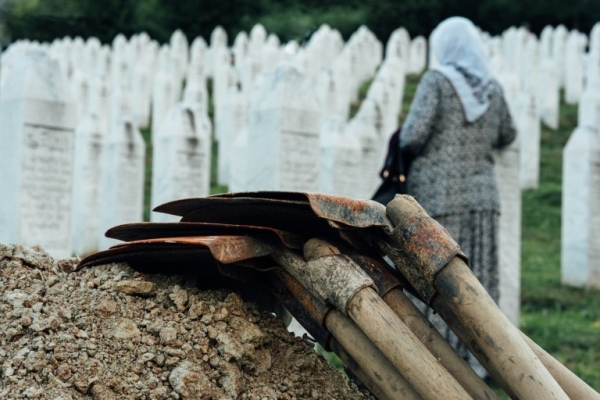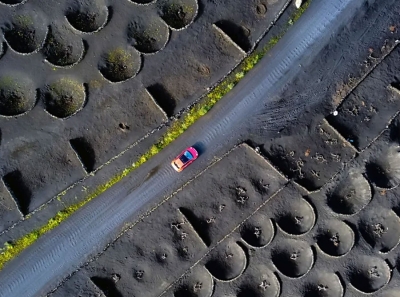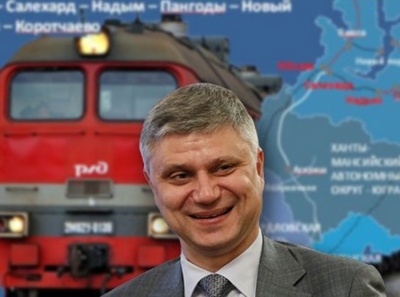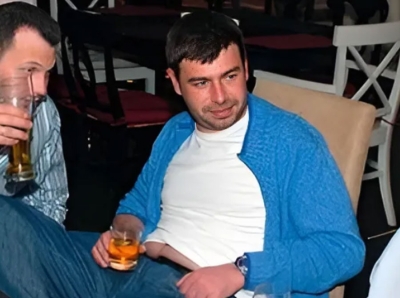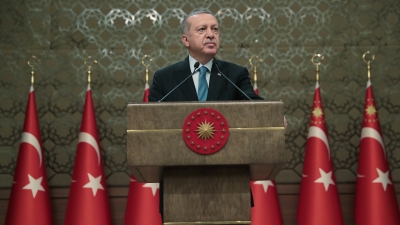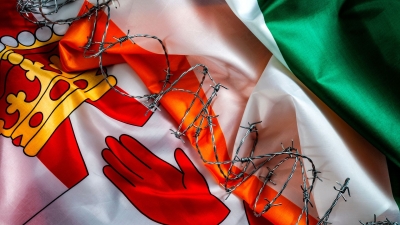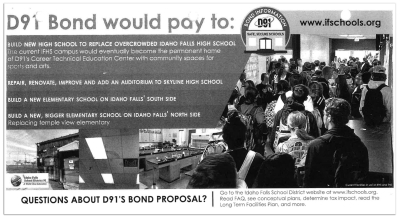Widely ignored official reports and never-before-seen declassified files suggest shadowy British special forces operatives played a crucial role in one of the 20th century’s most notorious and controversial massacres.
In July 2023, few media observers took notice when influential British intelligence operative-turned-lawmaker Alicia Kearns issued a public call for Western boots on the ground in the former Yugoslavia.
Addressing a packed session of the House of Commons, Foreign Affairs Committee chair Kearns made the alarming call: “I…urge the Government: let us rejoin EUFOR, let us commit NATO peacekeepers to Brčko district, let us transition to a NATO-led peacekeeping mission in Bosnia and Herzegovina.”
The incendiary comments came during a parliamentary debate on Srebrenica Memorial Week, which commemorates the massacre of Muslim men and boys in Srebrenica by the Army of Republika Srpska (VRS), in July 1995.
Grave crimes were subsequently committed there, many of which remain unpunished. Yet three decades later, details of what happened that fateful month, including the total number of people killed and the exact nature of their deaths, remain uncertain. Whether the horror constituted genocide also remains a point of contention among legal scholars.
Nonetheless, Western leaders have frequently invoked the event to justify illegal military interventions. Bombing campaigns targeting troublesome countries across the Global South are frequently framed as righteous actions, concerned with preventing ‘another Srebrenica.’ For notoriously hawkish USAID administrator Samantha Power, this objective became the cornerstone of an insidious brand of liberal interventionism which has come to be known as “Responsibility to Protect.”
But the exploitation of Srebrenica to justify further warfare is not limited to Washington. British officials are particularly keen promoters of this argument, with the hawkish intelligence operative turned parliamentarian Alicia Kearns providing the latest example. Today, Britain is the only country other than Bosnia and Herzegovina to officially commemorate the killings an act of genocide. Since the late 1990s, London has also been home to many NGOs that have promoted the claim that Srebrenica constituted an act of genocide.
However, in all the memorializing of the tragic events of July 1995 by British journalists, pundits and politicians, the presence of the SAS in the area at the time has stubbornly remained an open, unexplored secret.
Declassified British Ministry of Defence files reviewed by The Grayzone raise disturbing questions about London’s clandestine role in Srebrenica, such as how and why the MI6 knew an attack on the enclave was forthcoming before the VRS even planned it. Today, British citizens and residents of Bosnia still demand answers.

SAS in Bosnia ‘could cause World War III’
Seven years later, the Dutch government published its official investigation of the failure of its peacekeeping force to protect Srebrenica, which was compiled by the Netherlands Institute for War Documentation (NIOD). Six days after the release of the findings, Prime Minister Wim Kok stepped down. The Netherlands ultimately accepted partial political responsibility for the massacre after the country’s Supreme Court declared the Dutch government bore 10% of the liability for the incident.
Littered throughout the report are remarkable passages referencing the presence of a “secretly operating British unit” in Srebrenica. British special forces personnel embedded at Dutchbat HQ were described as “Joint Commission Observers” (JCOs), but the NIOD report notes that “in reality these were units of the Special Air Services (SAS) and Special Boat Service (SBS),” which conducted “reconnaissance missions” and “special assignments” on the order of General Michael Rose, who led Britain’s UN peacekeeping force in Bosnia during the war.
The British operatives’ relationship with Dutchbat was “not good,” the NIOD concluded. Dutchbat apparently had little knowledge of the activities of the JCOs, whose operations in Srebrenica were so secretive that even the Netherlands’ Defence Crisis Management Centre, which oversaw the country’s operations in Bosnia, “did not know of the JCOs’ presence of in the enclave.” But the Dutch suspected that the British JCOs’ main task was spying on them. “The primary underlying objective of the JCOs in Srebrenica was to gather intelligence on Dutchbat and to discover whether anything illegal was happening between Dutch troops and Muslim forces,” the report notes.
SAS operatives were posted in areas of Srebrenica overseen by Scandinavian peacekeepers, who were not authorized to give orders to their British counterparts. The Scandinavians were also kept in the dark about the nature of the JOC’s activities, and were only permitted to know the locations of their movements after negotiation. The Norwegian colonel who oversaw the battalion said that the elite British soldiers moved “hither and thither” throughout eastern Bosnia with impunity, and they “occasionally got caught up in skirmishes” along the way, according to the NIOD.
While details of specific SAS operations are sparse, one of the few concrete examples of JCO activities cited by Dutch investigators makes it clear their Bosnian remit extended well beyond mere intelligence-gathering. At one stage, the report’s authors note, there was a “special SAS operation involving ambulances, which carried communication equipment instead of stretchers.”
“These ‘ambulances’ were donated to Bosnia by [British health authorities] out of humanitarian considerations, but would often suddenly appear in the most surprising places,” the report notes.
Under Geneva Conventions, use of vehicles with medical markings for military purposes is a war crime. But such deception is par for the course for the Special Air Service, whose name itself is a direct product of a World War II era plan to fool Axis powers into believing the UK had a full parachute regiment at its disposal in the region. And there’s little to suggest the military outfit has changed its ways in the time since. In 2015, reports emerged about the SAS mounting raids in ISIS-occupied territory in Iraq and Syria, disguised as the group’s fighters.
Two years later, armed members of the SAS Counter Revolutionary Warfare Wing were allegedly posted on British streets, posing as street sweepers and vagrants in an ostensible effort to avert terror attacks. Throughout NATO’s occupation of Afghanistan, SAS death squads routinely executed innocent, unarmed civilians then falsified evidence to falsely convict their victims as armed insurgents.
In Bosnia, according to an anonymous Dutch peacekeeper consulted by NIOD, members of Dutchbat “were afraid of the British and that they could cause the Third World War.” If the JCOs were purely concerned with intelligence gathering, this seems a rather peculiar appraisal.

SAS ‘pretended’ to call in airstrikes
When Srebrenica fell on July 11, the NIOD report notes that two JCOs appeared at the local UN Military Observer headquarters early in the morning. They claimed to be an “aircraft contact team,” tasked with identifying locations for NATO airstrikes, which would prevent the VRS from capturing the area. A Muslim army liaison duly guided the SAS operatives to a vantage point on a hill providing clear views of Srebrenica, which they believed would ensure “excellent contact with the aircraft.”
The liaison told NIOD that the JCOs “were in constant contact with someone” throughout this time. Roughly half an hour following their arrival to the hill, they “saw clear relief on the faces of the British,” for reasons unclear. The SAS men then reportedly claimed they couldn’t call in airstrikes after all, as their satellite phones were out of battery.
When their position came under VRS fire, the JCOs took cover in nearby trenches occupied by Muslim soldiers, “who had no idea what they were doing there.” Per the report, the British nonetheless “felt safe and relaxed,” removing their helmets and flak jackets once inside. Curiously, their liaison recalls that they “pretended [emphasis added] to make radio contact, but remained seated and did not appear to be planning any further action.”
The British had ample reason to believe an assault on Srebrenica was coming in the weeks prior. As the NIOD report points out, on June 8 Muslim representatives met with the JCOs, providing “detailed plans of an imminent attack” on the enclave. However, “this did not lead to any alarms being sounded,” allegedly due to the frequency with which unfounded rumors of an impending VRS invasion of Srebrenica had circulated over the previous three years.
The NIOD report notes that the JCOs also doubted an “imminent attack,” as they “received no confirmatory evidence for the plan.” Dutch officials argue this is an indication “British intelligence services knew of no such plans.” Yet, the JCOs believed this information suitably significant, they informed Dutchbat’s leadership. Moreover, declassified British Ministry of Defence files reviewed by The Grayzone indicate that MI6 intelligence at the time believed “the Serbs would attack Srebrenica.”
This was not the same information supplied by the Muslims to the JCOs. The declassified files show MI6 shared their intelligence with Amsterdam, and the NIOD duly sought permission to cite this in its Srebrenica report. But London refused, citing supposed concerns with protecting sources and preventing its “material” being used in “non-UK public/legal proceedings.”
The same documents warned that British officials testifying to a then-ongoing UN inquiry into Srebrenica needed to keep quiet about what they knew. “If asked about the existence of intelligence relating to events in Srebrenica, they should simply respond that they are not authorized to discuss such matters,” the files state.
Srebrenica allowed to fall?
Based on countless hours of witness testimony and reams of primary source evidence, investigators for the NATO-created and funded International Criminal Tribunal for the Former Yugoslavia (ICTY) concluded planning for the Srebrenica assault only began on June 30 — a week prior to its execution.
This raises the obvious question of how MI6 and Muslim forces both independently knew earlier that month an attack was pending, and what exactly they foresaw. Per the ICTY, the VRS initially intended to simply chase away Muslim military units operating around Srebrenica, then encircle it to prevent further attacks on Bosnian Serb territory. There was no question of striking the enclave itself.
With only 2,000 VRS troops involved in the operation, and an estimated 6,000 Muslim soldiers waiting for them in and around Srebrenica, it was not expected to be an easy victory. The decision to overrun the enclave was made on either July 9 or 10, after the VRS encountered virtually no opposition en route.
A July 11 British Ministry of Defence memo noted that “the recent BSA [Bosnian Serb Army] attack on Srebrenica was prompted by constant [Muslim] attacks over the previous three months on BSA supply route to the south of the enclave.”
“The BSA action is in direct response to [Muslim] pressure on a BSA line of communication and the BSA reacted by forcing [the Muslims] back towards Srebrenica…The Serbs found there was little resistance so they were able to exploit further than their original objective.”

This lack of resistance apparently left Dutchbat stunned. On July 6, they informed Muslim forces that if the VRS entered Srebrenica, they would release to them the contents of a UN weapon collection point in the area, which contained a sizable arsenal, including heavy weapons. But when the VRS arrived, the Muslims “did not avail themselves of this opportunity,” according to a Dutchbat debrief.
“The advantages militarily seem to have been with the defenders to at least hold out for rather longer and have inflicted greater losses on the [VRS] than believed,” a separate UN Military Observer report concluded. However, “the [Muslim] leadership seems to have actually acted against their own interests to carry out a successful defence, with little coordination…and no attempt to seize the heavy weapons held by the UN.”
Dutchbat was authorized to call in NATO airstrikes, which they did with mounting urgency as the VRS overwhelmed Srebrenica. Yet intervention was not approved by the alliance until late on July 11, when the enclave’s total capture was complete. Geoffrey Nice, a controversial British lawyer who led several ICTY prosecutions, has unearthed a secret agreement struck in May 1995 between Britain, France, and the US that there would be no bombing campaign to defend the area.
Secret SAS operations during massacre
That agreement could also explain the JCOs’ bizarre behavior during Srebrenica’s fall. Evidently, local Muslim forces expected NATO airstrikes once the VRS arrived, and the British apparently gave them ample grounds for believing these would be forthcoming. Their false promises may account for Muslims’ lack of resistance against VRS incursions.
Once the VRS was in full control of Srebrenica, they evacuated Muslim women and children, while rounding up males of military age, although some of their captives were considerably younger and older. Their purpose was to identify individuals responsible for attacks on Serb areas. NIOD reports at this time, a senior Dutch military official “made various attempts” to verify claims of “war crimes” in the enclave, which included ordering “someone” to ask the JCOs if they’d uncovered evidence to that effect.
The SAS operatives allegedly reported very little, despite regular extended absences from Dutchbat HQ during and after the VRS capture of Srebrenica. NIOD notes that “shortly after the fall” of the enclave, a United Nations High Commissioner for Refugees representative and their interpreter witnessed one of the British soldiers return to base late one night, “completely drenched in mud ‘as if he had only been crawling.’”
Such activity is rendered all the more suspicious, given the JCOs apparently “as a precautionary measure, destroyed their special communications equipment” on either July 11 or 12. This reportedly resulted in a “break in communications” between them and the inquisitive Dutch military official for some time thereafter — exactly when the massacre of Srebrenica’s male population allegedly began.
As British authorities forbade NIOD from speaking to the SAS operatives, there is no information on their activities during this period, and whether or how they may have received orders. Another Dutch military official who attempted to trace the SAS operatives through Britain’s diplomatic mission in The Hague was rebuffed, a decision they suspected this resulted from “the political sensitivity of the presence of the British in Srebrenica at the time of the fall.”
NIOD did learn that three of the JCOs were awarded British military honors for their service in Srebrenica, whatever that was. From their July 11 vantage point, the SAS could keenly monitor the situation on the ground, and notify their controllers when the enclave’s takeover was complete. Was ensuring this came to pass their actual mission? Did they feel “relief” that grim morning because they received confirmation airstrikes ordered by Dutchbat would not materialize until it was too late?
The Srebrenica ‘trap’
When Srebrenica was designated a UN “safe area” in April 1993, the Muslim leadership warned that its population were “threatened with extinction,” and “thousands of women, children and elderly” would be massacred if the VRS seized the enclave. Curiously though, both the government in Sarajevo and local Muslim military forces repeatedly blocked UN attempts to evacuate the area.
That month, armed fighters surrounded a massive UN convoy intended to transport thousands of inhabitants of Srebrenica to safety, prompting Muslim commander Naser Oric to turn it away. He claimed the rescue could not be permitted, as it would lead to VRS occupation of the enclave.
General Philippe Morillon, who commanded UN peacekeeping forces in Bosnia in 1992/93, has posited a rather different rationale. He claimed Sarajevo’s Western-backed President Alija Izetbegovic sabotaged evacuation efforts as he “was not in a position to strategically win a battle”:
“The aim of the Presidency of Bosnia, from the very outset, was to ensure the intervention of international forces for their own benefit…this is one of the reasons why they never were inclined to engage in talks.”
In 1993, Morillon said, he foresaw “something terrible” happening in Srebrenica due to Oric’s use of the enclave to attack Bosnian Serb territory. Frequently targeting undefended villages and taking no prisoners, including on religious holidays, Oric’s militants had a fearsome reputation for torturing, mutilating and brutally murdering their victims. Despite gleefully displaying video footage of this bloodcurdling handiwork to Western journalists, he was never prosecuted or punished for his crimes.
These tactics plunged Bosnian Muslims and Serbs into a “hellish” cycle of violence, Morillon argues, meaning when the VRS overran Srebrenica, “they wanted to take their revenge for everything that they attributed to Naser Oric.” In the weeks leading up to the assault, Oric’s forces slipped past UN peacekeepers to attack Bosnian Serb civilian areas near the enclave on multiple occasions, razing houses, stealing livestock, killing residents, and leaving survivors homeless.
Recognition that such actions would inevitably provoke a brutal retaliation might account for why the Muslim army warned Dutchbat an attack on Srebrenica was forthcoming. According to Morillon, the massacre that purportedly unfolded was exactly what Western forces, and the Muslim leadership, wanted.
The VRS “entered an ambush in Srebrenica, a trap, in fact,” and the population was “the victim of a higher interest…located in Sarajevo and New York,” he explained. Meanwhile, Srebrenica’s wartime police chief has repeatedly claimed that Izetbegovic told him if the VRS overran the enclave and slaughtered 5,000 Muslims, it would lead directly to NATO intervention.
That account is corroborated by the UN Secretary General’s report on Srebrenica’s capture. It notes members of a Muslim delegation dispatched to peace talks on a British warship in September 1993 were openly told by Izetbegovic:
“NATO intervention in Bosnia and Herzegovina was possible, but could only occur if the Serbs were to break into Srebrenica, killing at least 5,000 of its people.”
What are the British hiding?
As Izetbegovic apparently forecast, NATO intervention finally came at the end of August 1995, in the form of a month-long bombing campaign targeting the VRS, which killed up to 2,000 civilians. Three months later, the Dayton Agreement was signed, and the war brought to a close.
Several Bosnian Serb leaders were subsequently convicted of genocide by the ICTY, which charged them with engaging in a “Joint Criminal Enterprise” by capturing Srebrenica. Under this extraordinary and highly controversial legal doctrine, a defendants can be found guilty of crimes they did not personally commit, approve of, or even know about at the time they were committed.
None of the trials produced evidence that an order was ever given at any command level to massacre Srebrenica’s male population. When the ICTY convicted General Radislav Krstic on charges of genocide, the tribunal conceded that the commander of the multi-ethnic VRS corps which seized Srebrenica was not only unaware of and uninvolved in alleged war crimes, but explicitly ordered his soldiers not to harm civilians.
Just one individual was convicted by the ICTY of direct involvement in Srebrenica: a PTSD-ravaged soldier named Drazen Erdemovic. In return for testifying in multiple Tribunal trials — despite experts ruling him mentally unfit to be tried himself — he served only three-and-a-half years in prison, then entered a witness protection program. During his numerous heavily-coached Tribunal appearances, his memory escaped him on many key facts, including his own military rank, how many people he personally executed, how many his unit killed in total, when the massacre happened, and who gave the order to carry it out.
Erdemovic eventually settled on the implausible scenario that a low-rank soldier in his unit relayed the genocidal instructions to him on behalf of a lieutenant colonel, whose identity he claimed to not know and which has never been ascertained. Equally implausibly, he alleged his unit slaughtered up to 1,200 people in groups of 10 at a time, in just five hours. Despite implicating eight fellow soldiers in his testimony, they were never prosecuted, or even interviewed as witnesses by the ICTY.
British intelligence played a significant role in gathering evidence of war crimes in Yugoslavia for the ICTY. Well-connected British judges and lawyers were central figures throughout its proceedings, which spanned 23 years. British authorities — including the SAS — took the lead on capturing Bosnian Serbs indicted by the Tribunal. One of the convicted genocidaires, Radovan Karadzic, is currently imprisoned in Britain. Yet at no point during the trials was the secret SAS unit operating in Srebrenica mentioned, let alone called to testify.
Whether that implies their testimony could have raised problems for ICTY prosecutors, or they have something deeply sinister to hide, is difficult to determine. But it is beyond dispute that British officials consistently blocked proposals to undo a UN embargo on arms shipments to Muslim forces during the war, apparently due to what then-U.S. President Bill Clinton reportedly described as London’s desire for “a painful but realistic restoration of Christian Europe.”
Despite thousands of dead Muslims, that wish has gone unfulfilled. For those who hoped to Balkanize the continent’s last remaining major multiethnic state, however, the war was an unqualified success.

